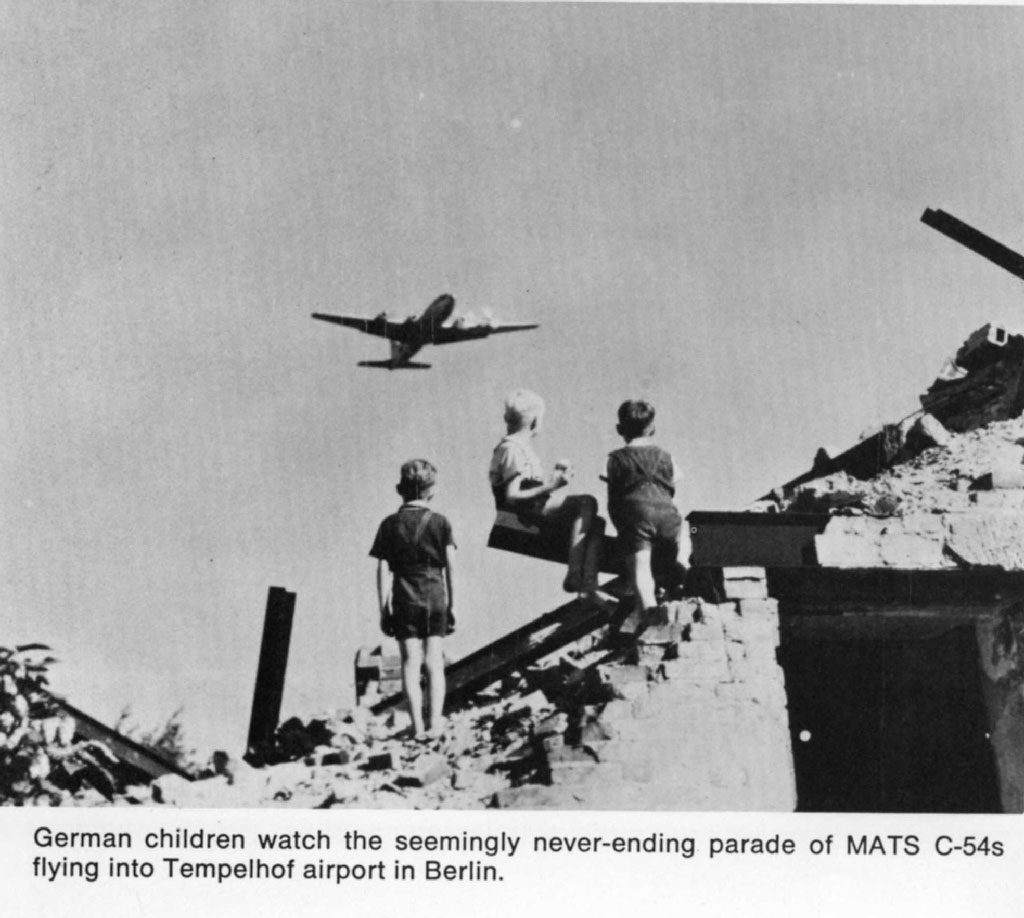
What is a normal MATS operation like? Well, there is no such word as "normal" in the MATS dictionary. A normal, uneventful operation would be a rare exception to the usual MATS rule. If it wasn't an earthquake in Chile or a typhoon in Japan, then it was sure to be a "brush-fire" war in Indochina, trouble in Lebanon, aggression in the Formosa Strait, a disturbance in the Congo, or some other "normal" situation somewhere else in the world.
And more often than not, these disturbances come one on top of the other - they overlap. But MATS is flexible and takes them as they come - either one at a time, or two or more together. It was that way from the time MATS began in 1948.
The Soviet officer angrily shoved his chair away from the conference table and rose to his feet. His face was impassive and, as he strode from the room, the rows of medals on his chest swayed beneath the high-collared tunic of his Red Army uniform.
It was June 16, 1948. The place was the Kommandatura, the headquarters of the Allied governing body for occupied Berlin. The withdrawal of the Russian commandant signified the end of the Soviet participation in the Four-Power control - (American, British, French, and Russian) - of the city.
This decisive act had been preceded by months of constant pressure and indignities imposed by the Soviet Union - a Soviet "walkout" from the Allied Control Council in March, followed by a series of Red-imposed restrictions on transportation and communications in and out of West Berlin.
Exactly one week after the Soviet military commandant left the Kommandatura, the Soviets put a complete stop to freight traffic into West Berlin. They suspended parcel post service and cut off electric power. The following day, June 24, Soviet officials issued orders stopping all surface transportation and the movement of supplies into the western part of the city.
The total blockade of West Berlin had begun!
The Soviets were determined to force the Western Allies out of Berlin and starve the West Berliners into the Communist orbit.
They tore up tracks and closed the railroad freight routes. They stopped barge traffic on the rivers, destroyed bridges, and blockaded the autobahn (German express highway) and other roads.
West Berlin was completely isolated - an island of freedom 110 miles within the Soviet Zone. But - what about the air? On that score, the Reds hadn't reckoned with the determination of the Western Allies. Britain, France, and the United States still had access rights to Berlin through three designated 20-mile-wide corridors.
Would the Russians try to stop them? How could they? Would they risk a third world war by trying to shoot them down? Anyhow, could the Western Powers possibly bring in enough food, coal, medicines, water, and other essentials by air to sustain the beleaguered city?
As for the Reds, they doubted it. It couldn't be done!
It was Sunday, June 26, when the historic Berlin Airlift got under way. Few of the participants - the pilots, crews, and the two million West Berliners - can forget it. (Nor, for that matter, can the Russians or the rest of the world.) Most could tell you precisely what they were doing at the moment they heard the news. The Germans called it Luftbruecke, or "air bridge," but officially it was known as "Operation Vittles."
Barely two days after the blockade had begun, the first military air transports began to arrive in West Berlin, loaded to capacity with the needed supplies. That same day the wires literally crackled as orders went out to the U.S. Air Force's Military Air Transport Command and Troop Carrier Command units around the globe. Soon MATS transports, which had been on routine or regularly scheduled flights, were winging their way toward Germany from Alaska, Japan, the Philippines, Hawaii, Australia, the Azores, England, and the United States. Organized only a scant four weeks before, MATS was about to perform the function for which it was created - it was undertaking the biggest strategic airlift job in history.
The first day's operations fell to the responsibility of Gen. Curtis E. LeMay's U.S. Air Force in Europe (USAFE). Using the only transport aircraft they had - the twin-engine Douglas C-47's - they delivered 80 tons of milk, flour, and medicine - all on that first day. The C-47 transport, known fondly as the "Gooney Bird," was a veteran of the Hump operation in World War II. As the civilian model DC-3, these planes had also been the workhorses of the commercial airlines since the early 1930's.
Within a week, MATS and TCC four-engine C-54 Skymasters were beginning to take up the task, and the tonnage volume of supplies began to move up.
By sweating and straining they were able to haul 384 tons for a 24-hour period ending on June 29. That day, three days after the lift had begun, the operations officer predicted that by July 20 they would be carrying 1,500 tons a day. His fellow pilots thought that he was completely out of his mind! They knew what an overbearing task it had been to haul a quarter of that amount into Berlin. But again they did the impossible. In two weeks, on July 15, five days ahead of schedule, they exceeded the estimate by flying 1,530 tons to the besieged city.
Nobody in their right mind would have ever believed that they would soon be flying 5,000 tons a day, and that even that lofty figure would be exceeded.
On July 23, MATS was ordered to take over the direction of the airlift and a few days later, the MATS Deputy Commander, Maj. Gen. William H. Tunner, established his headquarters at Wiesbaden, Germany.
To many of the pilots and crews, the route to Berlin was a familiar one. They had flown it before in B-17 Flying Fortresses, B-24 Liberators, B-25 Mitchells, and B-26 Marauders, with heavy bombloads to pulverize the Nazi capital. Others had flown that same route in P-51 Mustangs, P-47 Thunderbolts, and P-38 Lightnings, flying protective fighter cover for the bombers.
But this was a different kind of mission. It was "Operation Vittles," and the loads they were flying now were bringing life to that selfsame city, instead of destruction.
What was it like flying the Berlin Airlift? Well, as any pilot who did will tell you: "It was no picnic."
Imagine, if you can, rows of giant Skymasters with their cargo hatches wide open and large 10-ton Army trailer trucks backed up to them. Busily engaged loading each aircraft are volunteer teams of DP's (displaced persons from Latvia, Estonia, Poland, etc.). Supervising the loading and making certain that the weight is properly distributed and lashed down is an Air Force noncom. Also bustling about are the plane's ground crew.

The first of the flying crew to arrive is the flight engineer who inspects the plane. Next, the pilot and copilot, who have already been briefed on weather, navigation, and intelligence - that is, Soviet fighter plane activity in or near the Corridor. They too make an inspection of the aircraft.
With the loading completed, the pilot calls the tower for instructions. The tower checks with the Frankfurt Flight Control Center and relays the plane's departure time and altitude assignment back to it. This information is vital. It gives the pilot his particular spot in the lift.
The planes flew at five different altitudes, starting at 5,000 feet. All of the C-54's at the same altitude were 15 minutes apart. The next layer of aircraft were 500 feet above them and so on until the fifth level were at 7,000 feet. Since the planes at each altitude level were 15 minutes apart, by simple arithmetic (dividing the five levels into 15 minutes) , we get a 3-minute interval between aircraft landing at Tempelhof Airport in West Berlin. Obviously, then, to avoid disastrous collisions in the crowded narrow corridors and the bustling airport, precision and timing were extremely important.
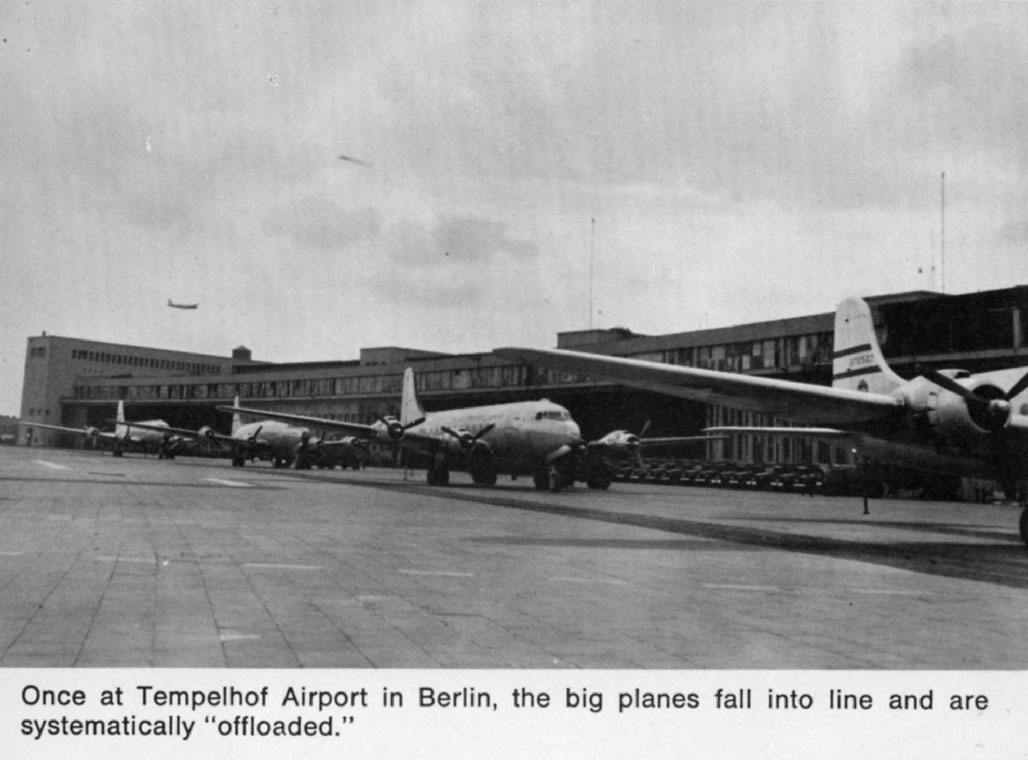
Now the pilot swings his plane around and taxis onto the long line of C-54's slowly inching their way to the takeoff position.
While waiting his turn, the pilot goes over his flight checklist with the copilot and flight engineer.
"Cowl flaps open?"
"Open."
"Tank selectors on main?"
"On main."
And so on down the list.
Twenty minutes after taxiing onto the line, the pilot had pushed the throttle forward and the Skymaster's powerful engines began to throb. Now they surge and rapidly pull the plane ahead and slowly lift it into the air. The pilot follows his takeoff heading until he reaches 900 feet and then turns toward Darmstadt, climbing at about 350 feet per minute at 160 mph. After flying 22 miles he swings around the Aschaffenburg Beacon and heads for the Fulda Range - the last directional guide this side of the Soviet Zone, and the last one until he gets to Berlin.
As he approaches Fulda, he can hear the next pilot, preceding him, reporting in. Our pilot checks his watch to make certain that he is in his proper position - three minutes behind. Precisely over Fulda he, in turn, reports so that the plane behind him can also check his position.
From this point, he's "on his own" and must guide himself by dead reckoning, all the while maintaining his assigned altitude and the indicated airspeed of 170 mph. Needless to say, there was always the danger of veering off course out of the narrow 20-mile-wide corridor, and so violating the restricted Soviet airspace.
Exactly forty minutes after reporting in at Fulda, the pilot tunes into the Tempelhof Field Control Station at Berlin and gets an altimeter setting and time check. Now he has five more control points to hit before he avoids the seven-story apartment house at the edge of the field, and finally touches down at Tempelhof.
Led by a "Follow Me" Jeep, the pilot guides his big plane to a designated station, where an unloading crew of Berliners is waiting for his priceless cargo. As he pulls up, a Post Exchange truck, with coffee and doughnuts, races up, followed by another car with a weather and an operations officer to brief him for his return trip, and a truck with a maintenance crew, ready to make any necessary emergency repairs. Shortly, he'll be winging his way back, ready to repeat the operation and bring another load in to Berlin.
What was it like? That was all there was to it - provided, of course, that the weather was good, no mechanical failures had occurred, and they hadn't been buzzed by Soviet Yak fighters.
At the height of "Operation Vittles," MATS alone had 4,000 officers and men and 300 C-54's (including some TCC aircraft) on the Berlin run. Nineteen more were used for training crews in a simulated Frankfurt-to-Berlin route - in the United States. Each of the planes flying the Berlin course was staffed with three crews. And this total did not include the U.S. Air Force C-47's and the Royal Air Force Yorks and Dakotas (also C-47's), and other miscellaneous aircraft.
Also not included in this total were the squadrons of Constellations (C-121's) and Globemasters (C-74's) that flew the supplies from the continental United States to Frankfurt, at which point the Berlin Airlift took over. Many thousands of miles of routes were covered by MATS and its Civilian Contract Carriers, Navy and Merchant ships, and Army Transportation Corps vehicles - to "feed" that short payoff stretch of a little more than 200 miles to Berlin.

It may be coincidental that the word "ton" is similar to "Tunner," but in air transport circles it was taken for granted. General Tunner was confident that the Berlin Airlift could have continued to deliver many tons of goods to West Berlin, forever. "We'll fly Vittles as long as the United States government wants it flown," he said.
But on May 12, 1949, eleven months after they imposed their restrictions, the Russians lifted the blockade. "Operation Vittles," however, continued, gradually tapering off in the early fall.
From the start of the blockade until August 1, 1949, the Berlin Airlift accomplished a Herculean task. They flew a massive 2,231,-600 tons into that city, averaging a fantastic rate of 5,579 tons a day. They made a total of 275,544 flights for an average of better than 700 flights a day - a monumental achievement indeed!
As President Kennedy said some twelve years later, when the Soviets again tried to isolate West Berlin, they "intend to bring to an end . . . our legal rights to be in West Berlin, and, secondly, our ability to make good on our commitment to the two million free people of that city. That we cannot permit."
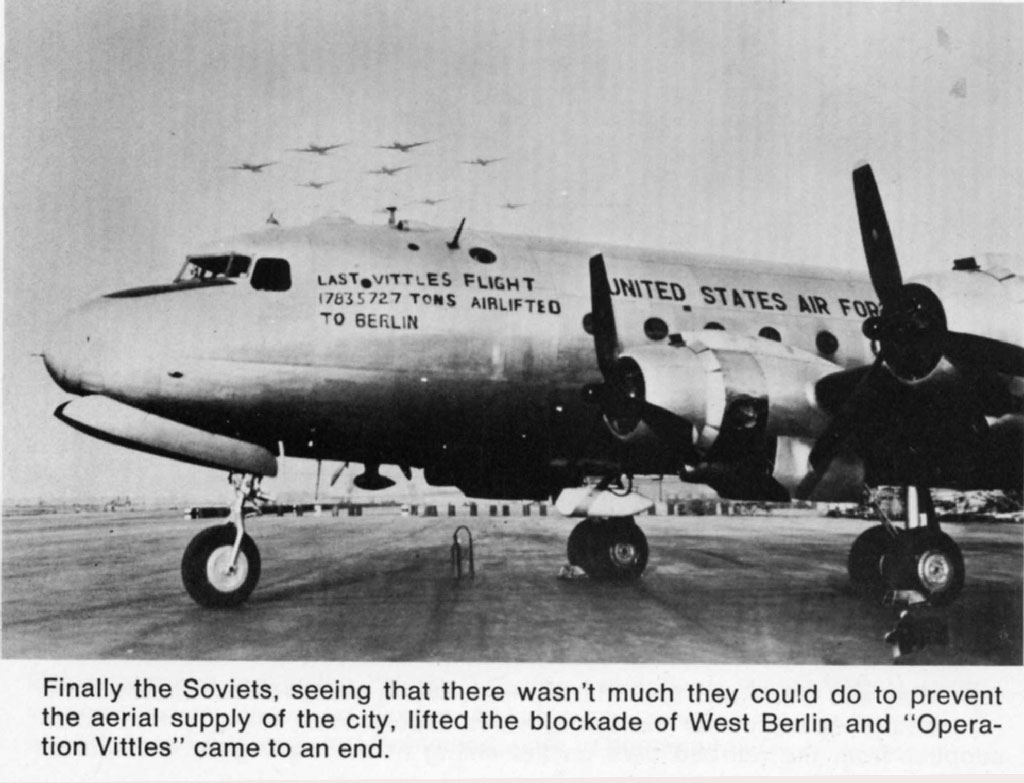
MATS did not permit it in 1948. They will not permit it today!
A group of French Foreign Legionnaires lay on the ground. Dirty, bloody bandages covered head and other body wounds. Some had missing limbs, some were moaning, and some were dying.
These Legionnaires were casualties in a war against Communist aggression. In the past, defeat was not a word in common usage in the legendary Foreign Legion, but this was the dismal situation they faced in 1954.
The place was a besieged fort at Dien Bien Phu, in what was then Indochina. The Legionnaires were under constant devastating artillery fire from the heavy guns of the Red Vietminh guerrillas emplaced in the hills surrounding the perimeter of the fort. A ragged blue, white, and red tricolor still fluttered over this last feeble French outpost in the Far East. More accurately, Dien Bien Phu represented, symbolically if not heroically, the end of the once glorious French Empire. Yet, for the Legion, which consisted of Germans, Czechs, Poles, Hungarians, Americans, Englishmen, Russians, and a sprinkling of Frenchmen, it was a long way from the traditional Foreign Legion home at Sidi-bel-Abbes, Algeria, in North Africa.
It was a long way home indeed!
But at the request of the French government, the U.S. Military Air Transport Service flew the wounded Legionnaires over 14,000 miles - more than two-thirds of the way around the world - back to North Africa and to France. As the crow flies, the trip to France from Indochina is considerably shorter, but for political expediency, MATS was obliged to fly them the other way. They went from Saigon to Tokyo, over the Pacific Ocean and continental United States, and finally across the Atlantic to Paris or to Oran.
MATS had planned on evacuating some 1,000 Legionnaires but a change of plan necessitated airlifting a total of 509 of the wounded. Included in this group were 331 litter cases. The balance were ambulatory patients, able to get aboard the aircraft and to walk and get along with considerably less help.
"Operation Wounded Warrior," as it was called, was carried out in ten complete missions. A typical "run" went something like this:
The wounded soldiers were taken by Japan-based U.S. Far East Air Force C-124's from Saigon to Tokyo. At Tokyo they were fed and briefed on the "overwater" journey ahead of them, and then were helped aboard the MATS C-97. At each of the subsequent stops, at Hickam Field in Hawaii, Travis in California, and Westover in Massachusetts, there were layovers of fifteen hours so that the evacuees would have time to rest. This portion of the journey was handled by MATS' Pacific Division. The Atlantic Division took over at Westover Air Force Base, and took their wounded charges over the Atlantic, to France or Algeria. In today's Military Air Transport Service organization, the Pacific Division is known as WESTAF (Western Transport Air Force) and the Atlantic Division is called EASTAF (Eastern Transport Air Force).
From start to finish the entire mission took less than a month. It began on June 26, 1954, with MATS taking over from the Far East Air Force on June 29. The last trip was completed on July 17, at Orly airport in Paris. Three of the other trips had terminated in Paris and the remaining six in Oran.
Three types of military transports were used to accomplish this humanitarian mission. These consisted of Douglas C-124 Globe-masters, Boeing C-97 Stratofreighters, and Douglas C-118 Liftmasters, as well as the MATS R6D's, the Navy designation for the Air Force C-118.
"Wounded Warrior" was the longest mercy mission in the history of the Military Air Transport Service. It brought to MATS the thanks and appreciation of a grateful France and the new nation of Vietnam. It also brought the undying devotion and gratitude of one of the world's greatest, most picturesque, gallant fighting forces - the French Foreign Legion.
After numerous border violations and aggressions against them, the troops of the new state of Israel attacked. Knifing across the Egyptian border, they routed the soldiers of dictator Gamal Abdel Nasser. Administering a sound trouncing to the Egyptian felahin who fled before them, the well-disciplined Israeli army continued to drive through the Sinai Peninsula toward the Suez Canal. There was no opposition. Egyptian officers and soldiers threw away their weapons and ran or surrendered in droves. It was a total rout. Mountains of arms and equipment that had been supplied to the Egyptians by the Soviet Union were captured by the victorious Israeli army.
Then England and France joined the fight, jumping in to side with tiny Israel.
But, at the eleventh hour, the United States acted, calling for an end to the war and admonishment for England, France, and Israel.
At this point the cease-fire and police action became a United Nations affair. Again MATS, the good right arm of United States diplomacy, took over its function of delivering UN troops to Egypt.
As always, a MATS operation is a global operation. This one was no exception. Immediately after the United Nations decision had been made to place their own police force in the Suez Canal zone, MATS was called upon to perform the major portion of the long airlift. Responding instantly on November 9, 1956, two Lockheed C-121 Super Constellations left the MATS base at Charleston, South Carolina, to make the necessary preparations for carrying the advance party of Colombian troops from South America. One of the C-121's
brought staging crews to Ramey Air Force Base in Puerto Rico. These were to serve as relief crews for the "Connies" arriving from Bogota on the first leg of the journey to the staging area in Capodi-chino, Italy. At the second stop on the long trip - the MATS installation at Lajes Field in the Azores - relief crews were ready and waiting.
Meanwhile, the second C-121 was on its way from Charleston to Bogota, Colombia, carrying the necessary control teams for operations, traffic, and maintenance, as well as other supporting personnel. The latter were charged with the responsibility of checking such things as airfields, runway lengths, communications facilities, tower control, lighting, and the suitability of the available local aviation gasoline. It was their decision to use the Palenquero Airfield for "onloading" the main force of Colombian troops, rather than Bogota. And the data gathered by the control team was used to brief all incoming flights.
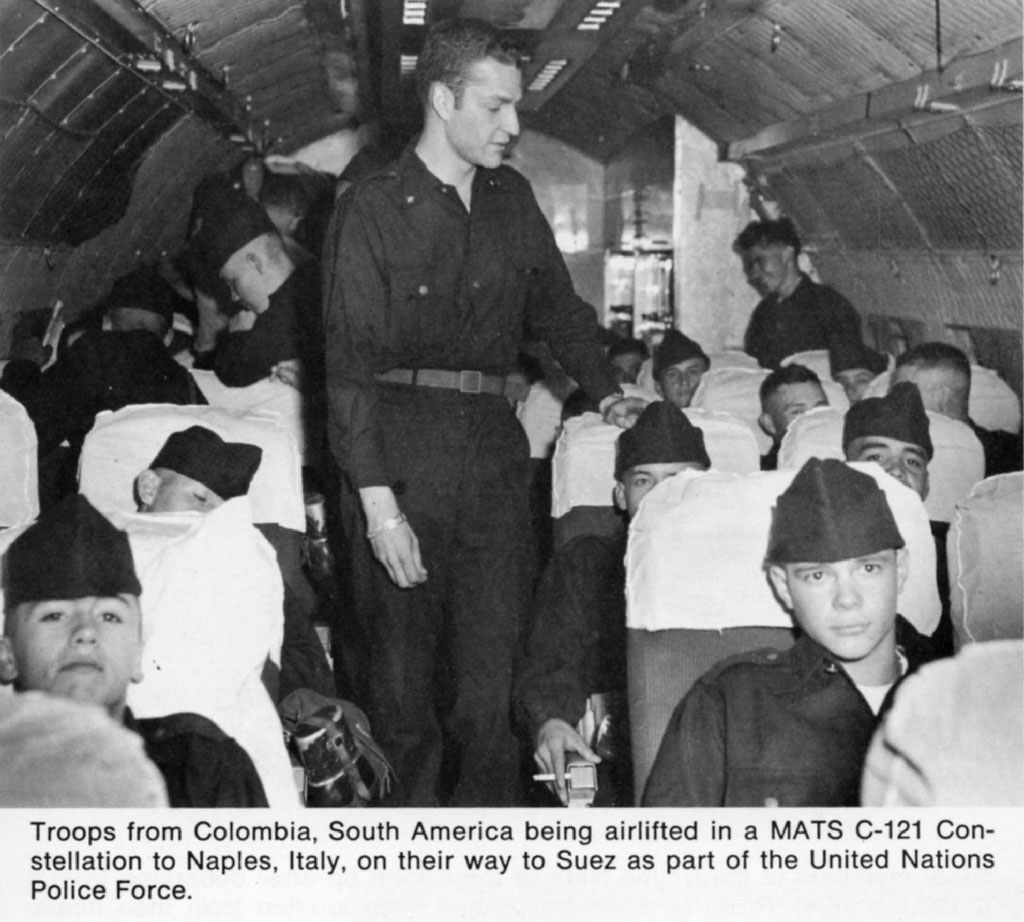
Soon the other MATS "Connie" arrived and the fifty-five officers and men of the Colombian army advance party were manifested, on-loaded, and the plane was airborne and on its way to Ramey, Puerto Rico; Lajes in the Azores; and Naples, Italy.
Then, with the completion of the airlift of this relatively small advance party, MATS was suddenly taken off the "alert status." It looked as though all of the preplanning and physical preparations for the larger mission had gone for nothing. Less than a day went by, however, when they were ordered to reschedule the flights through Khartoum in the Sudan to the USAF base in Dhahran, Saudi Arabia. The purpose was to make them available for the airlift of Indian troops from Agra as well.
Soon the Colombian airlift was in full swing again, but not to Khartoum and Dhahran, according to the amended plan; rather, it was going to be to Capodichino in Naples, as originally scheduled. In the Colombian portion of the Suez Airlift, the Military Air Transport Service carried a total of 585 soldiers and 35,000 pounds of baggage.
While all of this was going on, the Indian airlift materialized and the big MATS C-121's, with their distinctive triple stabilizers, took off to accomplish this new mission. In addition to the "Connies," C-124 Globemasters were diverted from the regular across-the-Atlantic "channel" run to the USAF cargo base at Chateauroux, France, and then rerouted from Dover AFB in Delaware to Wheelus, Tripoli; Dhahran; and on to Agra, India. Once at Agra, the MATS crews learned that each Globemaster would have to carry 31,000 pounds on every trip. This, in itself, presented no great problem. What did present a problem, however, was that the lift included thirty passengers for each plane. Since these were nonpressurized cargo aircraft and carried no oxygen for passengers, they were forced to fly well below their practical operating ceiling. This prevented them from flying the shorter northern route and necessitated returning the way that they had come - through Dhahran and Khartoum. The heavy loads, however, required the scheduling of trips through Khartoum in the early morning - before the sun reached its zenith, with the accompanying intense heat. The C-124's would have found it difficult taking off in the high temperature.
In one part of the operation, two R7VS (Super Constellations of the MATS Navy component) traveled more than 20,000 nautical miles from Hickam Field in Hawaii to Agra, India. From here they picked up the Indian soldiers and cargo, and then flew on to Capodi-chino, Italy. They finished the trip back to Hawaii by completely circling the globe. Although the entire trip lasted ten days, one of the aircraft made the "round-the-world" trip in well under four days' actual flying time.
Despite all kinds of problems and obstacles, including typhoons, MATS completed the airlift of Indian troops for the United Nations shortly before the close of 1956. In all, the Indian part of the airlift carried close to 1,000 soldiers and 275,000 pounds of cargo. This included the soldiers' baggage, arms and equipment, food, medical supplies, tents, water purification equipment, and other impedimenta.
Once again MATS proved that it was made of the proper ingredients to provide "instant airlift."
The lead tank rolled into the Budapest square, pivoted to the side on one track, and stopped. It was a Soviet heavy tank - a Josef Stalin III - and its big turret, bearing a Red star on each side, continued to rotate, the massive cannon and machine gun passing along the massed crowd of Hungarians lining the square. Like a giant finger it moved, as though pointing at each one, singling him out and serving a personal warning.
Then, the rest of the tank column pulled into the square.
The Hungarians had revolted against Soviet rule in 1956 and after a bloody battle the Russians had pulled out leaving the "Freedom Fighters" in control.
But now the Soviets had returned - and in strength. The taste of freedom had been short-lived. Thousands of Hungarian families fled die country by whatever means they could. They went by foot, bicycle, car, and hay wagon. Most of them stole across the border into Austria. Here, however, there were few facilities for them and the situation was getting more desperate as each day went by.
In its traditional role as haven and home for the oppressed, the United States agreed to accept 21,500 of these Hungarian refugees. Of this number, MATS had the responsibility of flying 9,700. Included were 139 escapees who required special aeromedical evacuation.
MATS, which had just completed its airlift in support of the United Nations in Suez, was ordered to undertake "Operation Safe Haven" on December 9, 1956. In less than two days the first MATS aircraft, a C-118, loaded with fifty Hungarian refugees, had roared off the runway at Munich-Riem Airport in Germany, on its way to the United States and freedom.
One hundred and fifty-five flights later, on January 3, 1957, another MATS Liftmaster flew in the last load of escapees to McGuire Air Force Base in New Jersey. During this 22-day period, MATS had fulfilled its mission, flying in its allotted quota of 9,700 Hungarian men, women, and children. With Phase I completed during the 3-week period, MATS went on to Phase II and by the end, on June 20, 1957, had boosted the total to 14,263.

This turned out to be the greatest peacetime airlift of civilians ever accomplished. And the entire operation was carried out without a single accident or mishap. Indeed, the name "Operation Safe Haven" was appropriate for more reasons than one.
"Safe Haven" was accomplished by the officers and airmen of MATS who worked night and day, even through the Christmas and New Year holidays. They were supported by U.S. Army personnel who also worked around the clock to provide the refugees with food, shelter, medical treatment, and processing at both the European and U.S. ends of the lift. Together they gave their Hungarian charges the very best Christmas gift anyone could ever receive - freedom!
President Eisenhower expressed it this way:
"Thus, we welcome you to American soil. We realize that you ardently hope for a time when all Hungarians can enjoy the blessings of individual freedom in their Hungarian mother-country. We join in that hope. And we give you this present assurance - if, when that day dawns once more, you should choose to go back to your native homes in Hungary, America will do its best in helping you to return."
Some 65 MATS aircraft participated in this humanitarian airlift. In addition to the C-118 Liftmasters, there were the big C-121 Lockheed Super Constellations, easily recognized by their distinctive bank of triple stabilizers, and the R6D's, the Navy version of the C-118. Also included were the planes of eleven commercial airlines that were under contract to the Military Air Transport Service for this operation.
Then it happened!
President Eisenhower received an urgent call for help from the Middle East in 1958. That tiny country, Lebanon - half Moslem and half Christian - was being threatened by a new form of indirect aggression. Sorely needed troops and supplies had to be airlifted to Lebanon as soon as possible. And it also had to be done without public knowledge, so as not to inform a possible enemy of the deployment of our troops.
Instantly the call went out for a task force of 36 MATS Globe-masters to report to Rhein-Main in Germany - within 36 hours. Considering the fact that the practical flying time from the United States to Europe, for the C-124, is 30 hours (including necessary stops for refueling), the deadline was an exceedingly close one.
The aircraft that flew in to join this Lebanon Airlift were actually based at Donaldson AFB, South Carolina; Larson AFB, Washington; and Dover, Delaware. MATS, with its global communications system, however, was able to catch them "on the wing" and divert this so-called "air alert force" from England, France, and the Azores in short order.
The first C-124 was at Rhein-Main in less than five hours, and the entire task force was in full operation two hours before the deadline. And within that period some of the Globemasters had already delivered their precious cargo to the eastern shores of the Mediterranean Sea.
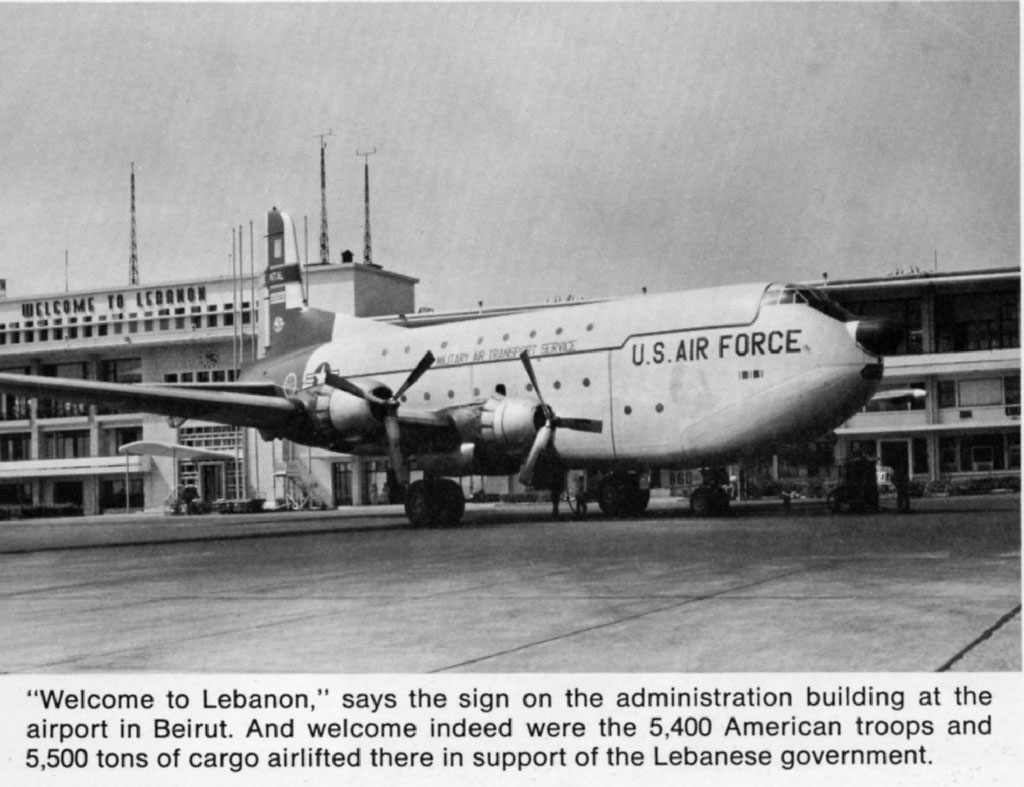
This task force furnished a strategic airlift to Lebanon for more than two months. The roar of the C-124 engines, as they swooped over the mosques and minarets, mingled with the voices of the Muzzeins calling the faithful to prayer. In all, the MATS crews flew over 7,000 flying hours, transporting some 5,000 passengers and more than 5,000 tons of supplies.
When the threat to Lebanon was neutralized, the United States soldiers, sailors, and Marines pulled out, along with MATS.
Summing up the Lebanon operation, President Eisenhower said:
"Two great lessons have been taught. First, the United States is a friend to those who wish to live their own lives in freedom. We are not deterred by threats or abuse from giving needed help. Second, the United States never seeks to turn the necessities of others into gains for itself. . .."
While all of this was going on in Lebanon and elsewhere in the world, the alarm bell rang again in August of 1958.
The Chinese Communists were shelling Quemoy and threatening Matsu. These tiny islands in the Straits of Formosa are the closest Nationalist territory to the mainland of China. Under heavy artillery fire, the Reds appeared to be softening up the little islands preparatory to an invasion. Again it was time to act. The U.S. Air Force's Tactical Air Command (TAC) was ordered to organize and send a Composite Air Strike Force to Formosa. This combined force consisted of jet fighters and bombers.
Once more MATS marshaled its forces to support the operation. Again, as in the Lebanon Airlift, there was no public announcement so as not to alert a possible enemy concerning our troop movements. Originally MATS had planned on 36 airlift trips operating out of three bases in the United States. However, this was increased to 80 trips from seven bases. But what was more important, shortly after the order was issued the striking force was at its destination - ready for action!
Although the operation was a complete success, there seemed to be one oversight. No F-104's were among the jet fighters sent to Formosa. This Starfighter was our latest, most modern, supersonic jet fighter. Called "the missile with a man in it," this Century Series fighter flies at 1,400 miles per hour - twice the speed of sound. So formidable a weapon was this that our military leaders felt we should have some of them on Taiwan - and that they should be there "yesterday"l
But how to get them there? The little jet fighters have only a short range. By the longest stretch of their capabilities (and of the imagination) , they could never span the vast Pacific Ocean. The urgency of the situation and the need for speed ruled out transportation by ship.
There was only one way - MATS was the answerl
Quick as a wink, MATS C-124's flew into Hamilton Air Force Base near San Francisco. There they were met by a squadron of Star fighters.
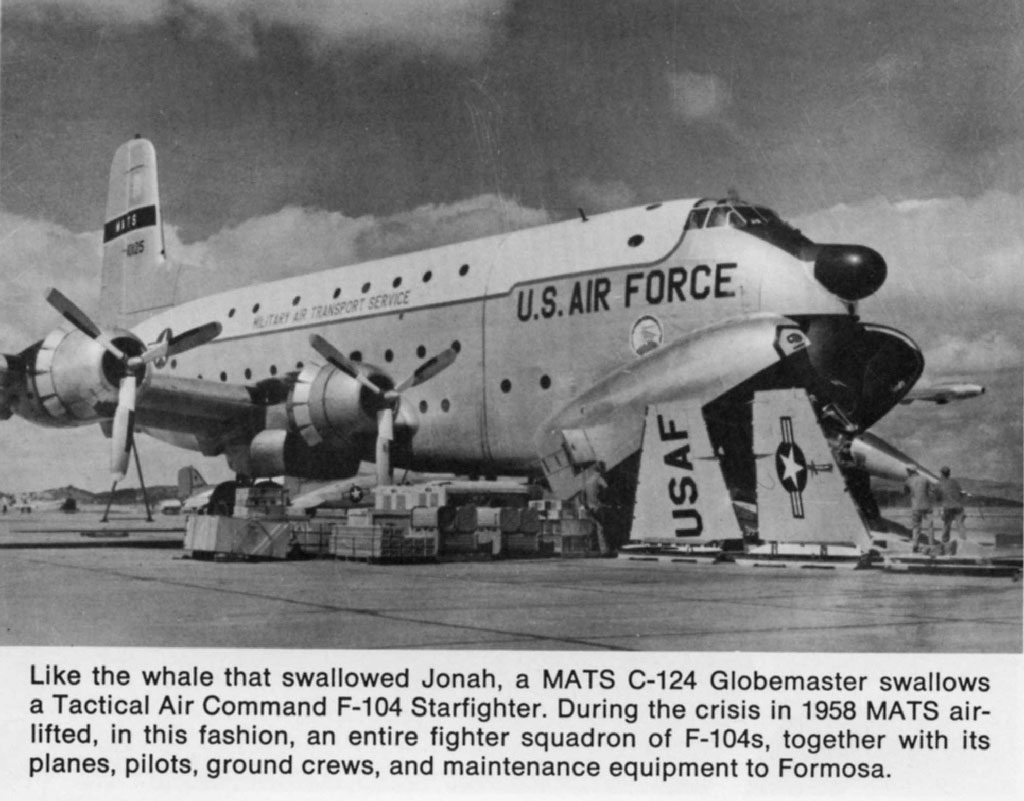
Do you remember the Bible story of how Jonah was swallowed by the whale and how he lived in the whale's belly and was eventually delivered? Well, "Operation Jonah Able" was the modern, multiple version of that Old Testament story.
Like some giant sea monster, the massive Globemaster stood with its jaws wide open. A "double take" was needed to make certain that your eyes weren't deceiving you. Yet, sure enough, the cavernous mouth of the MATS cargo aircraft was devouring, whole, a USAF jet fighter - a Lockheed F-104.
Not only did the Globemasters swallow the entire squadron of Starfighters, they also carried the fighters' pilots, ground crews, and maintenance equipment along and delivered them intact to Formosa. This operation marked a historical milestone in the annals of air transportation. It was the first time that a complete operational Air Force squadron was airlifted in a single-package operation.
During the Formosan crisis, MATS made 144 trips and ferried close to 2,000 passengers and 2,000 tons of equipment. And the Star-fighters they delivered may well have deterred another Communist aggression.
Taxiing down the runway at Leopoldville, the C-124 MATS Globemaster pulled up alongside of a big four-engine turboprop. Toward the rear of the foreign aircraft, below the rudder, were the large letters CCCP, which is the Cyrillic (or Russian) script for U.S.S.R. Along the center of the fuselage were the symbols which stood for "Aeroflot" - the Soviet state airline. In the United States, Aeroflot would be equivalent to a combination of MATS and all of the U.S. commercial airlines put together. In the Soviet Union there are no privately owned airlines. Aeroflot takes care of both civil and military air transport.
This Soviet aircraft was an II-18, which flies at the same speed as the Hercules. It was one of five of this type of plane reportedly participating in the United Nations airlift to the Congo, along with the numerous MATS C-124 and C-130 Hercules turboprops of the USAFE 322nd Air Division. In November, 1962, jet C-135's joined the operation.
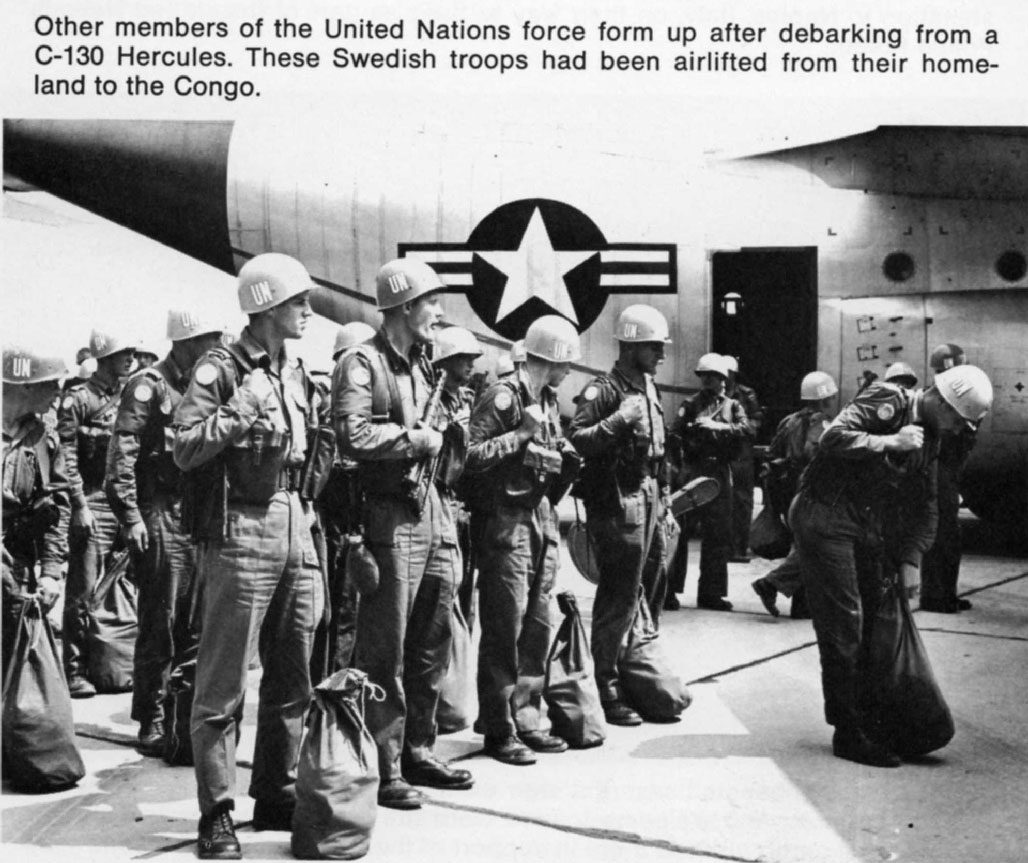
Despite the small number of Soviet transport aircraft in the Congo operation, it marked their first participation in a United Nations strategic airlift. It made this mission a true United Nations endeavor. For, in addition to the Pakistani troops and equipment that were brought in by the MATS C-124 tnat was taxiing down the runway at Leopoldville, other MATS aircraft had already airlifted a miniature United Nations of troops directly from their homelands to the Congo. They carried soldiers from Ireland, Ghana, Morocco, Guinea, Ethiopia, India, the United Arab Republic, Nigerian Tunisia, Sweden, Indonesia, and more.
Not only did MATS fly in troops and their equipment, they also airlifted badly needed food to the Congo. For example, four of the giant C-130 turboprops carried 200,000 pounds of dried fish more than 4,000 miles, from Flesland, Norway, to Luluabourg, during the last week of January, 1961. This was only a small part of the more than 1,100 tons of food ferried into the Congo by Military Air Transport Service C-124's and C-130's at that time.
What was all of this activity in the Congo?
In the heart of Africa, the shouts and joys of Congolese independence were short-lived. The Belgians, who had ruled over the Congo for eighty years, after much pressure and coercion had finally relinquished control. However, most of the 14 million Congolese were primitive people, poorly educated and ill prepared to govern themselves. The internal political struggle between rival political factions led to armed revolt, fighting, and bloodshed. The newly found freedom turned independence into mass confusion, a bloodbath and massacre of the former white rulers, the rise of a Communist force, and the secession of Katanga Province - the richest area in the Congo with practically all of the mineral wealth. On July 14, i960, just one week after the Congo had been admitted into membership, it became necessary for the world organization to act.
And again MATS swung into action!
During that first week, the Air Force had thrown 40 C-130*5 and 36 MATS C-124's into the operation, and was reinforcing with 24 more of the giant transports. In this initial phase of the airlift they carried more than 4,000 troops from five different nations, in addition to thousands of tons of food and equipment. Included in these shipments flown in by MATS were such items as communications facilities, maintenance equipment, helicopters, liaison planes, and even complete mess halls. At some points the airlift was a two-way shuttle - ferrying in UN soldiers and flying out returning Belgian troops, or UN troops that had been replaced, to their homelands. MATS also made emergency trips, flying the 663 nautical miles from L6opoldville to Stanleyville, and back, to rescue threatened refugees.
Meanwhile the C-124 that had just landed at Leopoldville had disembarked its complement of Pakistani soldiers. Having departed from the big USAF cargo base at Chateauroux, France, the aircraft and crew, at the completion of their journey, will have covered some 14,000 miles and will have been away just short of 561,4 hours before returning to their home base.
Here is the story of that C-124's flight from the beginning:
As the pilot pulled the control column toward his chest, the big Globemaster lifted off the runway at Chateauroux and headed southeast toward Italy. The pilot, a major with fifteen years' experience, was a veteran of the Berlin Airlift and the numerous other MATS strategic operations. He settled back about his duties. The C-124 carried eight other crew members, including copilot, navigator, flight engineer, and load master. For the Congo emergency some of these men were on temporary duty, from Donaldson Air Force Base in South Carolina.
Passing over a layer of wispy white clouds, they could make out the farms and tiny villages of southern France in the early morning sun. Before long these gave way to the blue Mediterranean, and finally the toe of the Italian boot passed beneath the wings.
The navigator looked up from his radar set and indicated a heading toward Cairo. Crossing the Mediterranean they were soon over the Gulf of Suez and bearing out over that vast expanse of sand that is the great Nafud Desert. But soon they were across it and landing at the great "oasis" - the big USAF air base at Dhahran, Saudi Arabia. There they found welcome food, drink, and rest, as well as fuel and maintenance for their aircraft, before taking off again for Karachi to pick up their passengers and cargo.
By the afternoon of the second day the Globemaster was settling down on the runway at Karachi. Soon Pakistani troops, looking very British in berets and coveralls, were stowing their gear aboard under the watchful eye of the MATS load master. And in short order, the full Pakistani contingent was smartly marching aboard to the tune of Scottish bagpipes.
Airborne again, the big plane headed back toward Dhahran - to spend the night at the "oasis" before shoving off for the Sudan and Khartoum. Taking off the following day from Khartoum, they could see the pattern of the streets laid out in the arrangement of the British Union Jack by Lord Kitchener in the late nineteenth century.
Next stop, Leopoldville! Soon after the Globemaster had taxied up alongside of the Russian II-18, the Pakistani troops debarked and off-loaded their baggage. The MATS task for this particular mission was completed. They had delivered a contingent of soldiers to the Congo for the UN Police Force.
Now, the job was to get back home.
Leaving the Congo, the transport headed northwest, over Equatorial Africa toward Kano, Nigeria. There was a slight delay while the flight engineer earned his keep - one of the four big engines was in need of emergency repairs, and he got to work on it. Soon the Globemaster was aloft again, bearing due north, 1,500 miles over the Sahara Desert, to Wheelus AFB in Tripoli.
Having refueled, the Globemaster was now on the last leg of its trip. Leaving the coast of North Africa behind, it was only a short time until the blue Mediterranean sparkled below. Soon, the fabled Cote d'Azur - the southern coast of France - appeared in the distance. In rapid succession the tiny villages, vineyards, and farms of southern and central France were seen once more. Then the pilot eased up on the throttle for a power letdown. The flaps were down, the wheels lowered, and soon the plane touched down with a screech on the field at Chateauroux. The major reversed the pitch on his four giant propellers and the Globemaster slowed down to taxi into position.
Another MATS mission completed successfully!
But, another MATS mission was also ready to begin in the seemingly never ending task of global airlift!
Communist guerrillas had driven the Royal Laotian army before them and had captured two important cities. Now they were pushing toward the Mekong River which separates Laos from Thailand. The tiny nation of Thailand, fearing Red aggression across the river, called for help in May of 1962. And the United States was quick to furnish it.
The United States, under the terms of the Southeast Asia Treaty Organization, was meeting its defense obligations to Thailand. Soon 5,000 U.S. soldiers, Marines, and airmen began to arrive at Bangkok, the capital and principal port of the little country that was formerly known as Siam. Fourteen hundred Leathernecks of the 3rd Marine Division in camouflage battle dress streamed ashore from a naval transport ship. They were following another 400 Marine airmen ferried ashore by helicopter from the U.S. aircraft carrier Valley Forge.
It was the middle of spring and the start of the monsoon season. In order to do the job they were brought in for, the troops had to be airlifted to the Mekong River - and quickly! That's where MATS entered the picture.
The very same night MATS heavy air transports were taking off every fifteen minutes from Don Muang airport outside of Bangkok. Like an aerial shuttle, they carried the American military personnel to Udon some 300 miles to the northeast.
In short order the Americans were in position, ready for anything. Often, all that is necessary is to show that you are ready and willing to stand up to an aggressor. The cold, hard reality that our friendly troops had been brought by MATS to the place they were needed at the time they were needed, most probably saved the day.
The Communist guerrilla forces did not cross the Mekong.
This was the first large-scale landing of U.S. combat troops and the first in Southeast Asia since the Korean War. It paved the way for the 20,000 American military personnel, helicopters, and other massive aid furnished to Thailand's neighbor, South Vietnam, in its struggle against the Red Viet Cong forces.
Many of these Americans gave their lives in South Vietnam from 1962 through 1964 in the never ending battle against the enemy guerrillas.